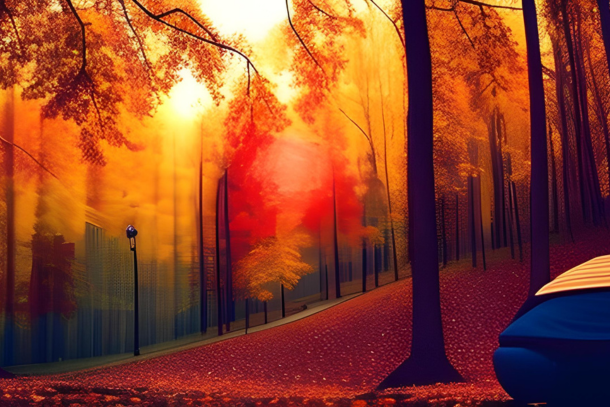The Ultimate Guide to Storm Sounds for Sleep: Your Path to Restful Nights

In the bustling hustle of our daily lives, amidst the incessant chatter of our minds, there exists a humble refuge - the soothing lull of storm sounds.
A New Trend: The Calming Cadence of Storm Sounds
A Soundtrack to Serenity
At first, it might sound a bit daft to purposely play the sound of a storm as you tuck in for the night. But, as more and more Britons are discovering, these stormy symphonies are not a catalyst for discomfort, but rather a beacon of tranquility. Whether it's the soft patter of rain on a windowpane or the low rumble of distant thunder, these natural symphonies have an uncanny knack of helping us drift off into a peaceful slumber.
The Rising Tide of Interest
Over the last few years, there's been a noticeable surge of interest in the effects of sound on sleep quality. This intrigue isn't just among the general populace, mind you. A growing body of research is shining a light on how certain sounds, particularly those found in nature, such as storm sounds, can significantly improve the quality of sleep. With insomnia being a common bugbear for many, the potential of storm sounds to bring on restful, uninterrupted sleep has attracted a well-deserved spotlight.
Navigating the Article
In this article, we aim to present you with a comprehensive guide to the wonderful world of storm sounds for sleep. We’ll delve into the science behind the calming effects of these sounds, explore why they’re an excellent choice for better sleep, and share practical tips on how to incorporate them into your nighttime routine. We’ll also help you discover the best platforms to access storm sounds and answer any questions you might have. So, stick around, and you might just find your perfect soundtrack to a night of serene, soothing sleep.
The Science Behind Sleep and Sounds
The Importance of Quality Sleep
The necessity for quality sleep cannot be overemphasised. A good night's kip is crucial for various bodily functions, including memory consolidation, cell repair, immune system enhancement, and the regulation of important hormones. It sets us up for the day, allowing us to function optimally both physically and mentally. However, despite being such a vital part of our lives, sleep can often be elusive. The modern world is full of distractions and stresses that can lead to poor sleep patterns.
The Science of Sound Therapy
Sound therapy, specifically through soothing sounds like white noise, pink noise, or brown noise, has emerged as a remarkable solution for sleep disruptions.
White, Pink, and Brown Noise
These sounds, all with unique acoustic properties, help in creating a consistent audio backdrop that can mask more disruptive noises.
White noise is an even distribution of sound frequencies, which is often likened to the gentle hum of a fan or the steady hiss of radio static. Pink noise is richer and deeper, with examples including steady rain or heartbeats. Lastly, brown noise, or Brownian noise, provides even deeper, more low-frequency sounds, akin to the rumble of a thunderstorm or a strong wind.
How Our Brains React to These Sounds
When we sleep, our brains continue to process sounds on a basic level. Noise inconsistency can lead to disturbed sleep. These types of consistent noise can mask other sounds in the environment, providing a stable sonic backdrop that can help the brain stay relaxed, thereby promoting better sleep.
The Role of Storm Sounds in Improving Sleep
Research suggests that natural sounds like storms can enhance sleep due to their rhythmic patterns. Storm sounds fall predominantly into the category of pink and brown noise, providing a soothing, deep noise environment that can aid in achieving a night of deep, restful sleep. The calming effect of these sounds can help to reduce stress and anxiety, further promoting sleep quality.
Why Choose Storm Sounds for Sleep?
Unique Characteristics of Storm Sounds
Every person is unique in their preference for the perfect sleep sound. Storm sounds stand out as a popular choice due to their rhythmic and consistent nature. They emulate a gentle, natural symphony with a soothing tempo that effectively lulls the listener into a state of calm. Unlike other white noises, storm sounds offer an array of mellow tones, ranging from the gentle patter of raindrops to the low rumble of distant thunder. This unique combination of sound frequencies can fill the silence and mask the unexpected noises that can disrupt sleep.
Storm Sounds and Stress Relief
Storm sounds aren't just sleep-inducing; they also serve as an effective tool for stress and anxiety relief. According to the principles of psychoacoustics, the branch of psychology concerning the perception of sound and its physiological effects, the soothing sounds of nature, such as the pitter-patter of rain or the rolling sound of thunder, can stimulate the release of serotonin, a hormone that helps regulate mood. The steady rhythm of these sounds can act as a sonic blanket, wrapping the listener in a cocoon of comfort and security that promotes relaxation and eases anxiety.
Testimonials and Experiences
It's always compelling to hear first-hand experiences from individuals who've discovered the restorative power of storm sounds. We've received numerous testimonials from people expressing how the calming nature of these sounds has significantly improved their sleep quality. One user from Manchester noted, "The rhythmic sounds of rainfall and the distant thunder help me drift off in no time. It's like nature's lullaby." These personal accounts reaffirm the effectiveness of storm sounds as a sleep aid and highlight the transformative potential of incorporating them into your nighttime routine.
Types of Storm Sounds for Sleep
The Diversity of Storm Sounds
When it comes to storm sounds, there's an astonishing diversity, each offering a unique sensory experience.
Light Rain
The soft pitter-patter of light rain on the windowpane can be remarkably soothing. It's a gentle, steady sound that can help your mind transition smoothly into a state of sleep. This sound is often best for those who find comfort in quieter, more subtle noises.
Heavy Rain
In contrast, heavy rain offers a more intense auditory experience. The constant downpour creates a white noise effect that can block out other potentially disruptive noises in your environment. This is ideal for sleepers who live in busy areas or have trouble ignoring small disturbances at night.
Thunderstorms
Thunderstorms bring an entirely different energy, combining the sound of rain with the occasional crash of thunder. These sounds are typically intermittent and can provide a sense of depth and variation that some find incredibly soothing. However, it may not suit everyone, particularly those who are sensitive to sudden loud noises.
Rain with Different Natural Elements
Storm sounds can also be complemented by other elements of nature, such as the rustling of leaves in the wind or the rhythmic lapping of ocean waves. These layered sounds can create a richer, more immersive soundscape that can potentially enhance your relaxation and sleep quality.
Choosing the Right Storm Sound for Your Needs
Selecting the right type of storm sound is highly individual. Factors to consider include your noise sensitivity, personal preferences, and the environment in which you're trying to sleep. Try different types of storm sounds and observe how each impacts your sleep quality. It may take a bit of experimentation, but the perfect storm sound for your peaceful night's rest is out there.
How to Incorporate Storm Sounds into Your Sleep Routine
In this section, we'll explore the practical ways to weave storm sounds into your nightly sleep ritual, setting the optimal volume and sound setup and experimenting with blending storm sounds with other tranquil noises.
Creating Your Sleep Routine with Storm Sounds
To enjoy the full benefits of storm sounds, it's best to make them a part of your bedtime routine. Start by selecting your preferred storm sound and playing it as you begin winding down for the night. You might choose to read a book, meditate, or simply lie in bed while you listen. Over time, your brain will associate these sounds with sleep, triggering relaxation and sleepiness whenever you hear them.
Setting the Right Volume and Sound Setup
Ensure the volume of your storm sounds is not too loud to avoid startling awake with unexpected claps of thunder. It should be loud enough to mask unwanted noises but soft enough not to disrupt your sleep. As for the setup, a speaker on your bedside table can provide a more immersive sound experience. However, if you share a bed with a partner who prefers silence, consider using headphones designed for sleep.
Mixing Storm Sounds with Other Relaxing Sounds
If you fancy a bit of variety, try combining storm sounds with other calming noises. Many people find the sound of rain against windowpanes particularly soothing when mixed with soft instrumental music or the gentle hum of a forest at night. Experiment with different soundscapes until you find the perfect mix that lulls you into a peaceful slumber. Remember, the aim is to create a relaxing atmosphere that encourages quality sleep.
The Best Platforms for Accessing Storm Sounds
It's time to explore where to find these soothing storm sounds that can lull you into a peaceful slumber. A plethora of online platforms and apps offer a wide variety of storm sounds. We'll delve into some of the most popular ones, scrutinising their pros and cons and recommending both free and premium options to fit everyone's needs.
Online Platforms and Apps
In our digital age, the internet brims with resources to find the perfect storm sounds. Websites like YouTube are a treasure trove of lengthy storm soundtracks, ranging from gentle rain showers to fierce thunderstorms. SoundCloud, an online audio distribution platform, also hosts a multitude of creators offering their unique blends of storm sounds.
Mobile Applications
If you prefer the convenience of a smartphone app, consider options such as Rain Rain Sleep Sounds or Relax Melodies. Both apps offer an extensive library of storm sounds, and you can even mix different sounds to create your perfect storm.
Pros and Cons
However, every platform has its advantages and drawbacks. YouTube's vast content and user-generated storm sound make it a superb free option. But, you might find ads disruptive unless you opt for their premium service, YouTube Premium.
SoundCloud offers a more curated experience with fewer interruptions. However, the content variability can be lower than on YouTube.
Mobile apps often provide the best user experience, with features like sleep timers and customisable soundscapes. However, most require in-app purchases or subscriptions to unlock their full capabilities.
Recommendations
For those on a budget, YouTube stands out for its wide variety of free storm sounds. If you prefer a more premium experience without ads, consider subscribing to Relax Melodies or Rain Rain Sleep Sounds. These apps offer a more personalised experience, with features tailored to enhance your sleep routine.
Caveats and Considerations
Whilst harnessing the power of storm sounds for sleep can prove tremendously beneficial for many, it's essential to address a few potential drawbacks and concerns. It's not a one-size-fits-all solution, and understanding this can help fine-tune your approach to ensure optimal results.
Potential Drawbacks and Concerns
Some individuals may find the sounds of storms unsettling or even anxiety-inducing rather than soothing. Thunder, for instance, can be associated with adverse experiences or childhood fears. It's also worth noting that prolonged exposure to sounds at a high volume, even relaxing ones like rain, can potentially lead to hearing damage.
Furthermore, a small fraction of individuals may become reliant on storm sounds to fall asleep, creating an unnecessary dependency. The thought of sleeping in a quiet environment or in the absence of the preferred sounds might turn into a source of stress.
Tips to Address These Potential Issues
If storm sounds initially create a sense of discomfort, try to start with gentle rain sounds before gradually introducing other elements, such as thunder. Experiment with different soundscapes to find the one that makes you feel most at ease.
Ensure you keep the volume at a comfortable level as if the sounds were present in a natural environment. They shouldn't overpower your senses but rather blend subtly into your surroundings.
To avoid developing a dependency, aim to use storm sounds as one of many tools in your sleep hygiene toolbox. Mix it up by alternating with other white noises, music, or simple silence. This way, you can enjoy the benefits without the worry of over-reliance.
Remember, the goal is to enhance your sleep quality and create a relaxing atmosphere rather than introduce new sources of stress or discomfort.
The Journey So Far
In our exploration, we've delved into the captivating world of storm sounds, appreciating their diversity and soothing qualities. From gentle rainfall to the impressive rumble of thunder, these sounds offer a unique soundscape that fosters relaxation and promotes quality sleep. Our journey led us to understand the science behind sleep and the role that sounds play, specifically how our brain reacts to white noise, pink noise, and brown noise.
Moreover, we've underscored the importance of selecting the right type of storm sound tailored to your personal preference and the practical aspects of incorporating these sounds into your bedtime routine. We've even ventured into the digital realm, examining various platforms that offer storm sounds and providing advice on both free and premium options.
An Invitation to the Sound of the Storm
Given this newfound knowledge, we encourage you to consider the magic of storm sounds. Why not add a sprinkle of rain, a whisper of wind, or the resounding echo of distant thunder into your nightly ritual? Your sleep routine could be transformed into a serene symphony of sounds that lull you into a tranquil sleep.
Related to this article are the following:
- Weather Sounds to Help You Sleep: Rain, Wind, Snow and Storms
- How to use a sleep diary to help improve your quality of sleep.
- Sleep Music: The Soothing Sounds for a Restful Slumber
- The Power of Relaxing Music: A Guide to Enhancing Your Well-Being
- Experience the Warmth: Uncovering the Benefits and Techniques of Hot Stone Massage
I do hope you have enjoyed this article and hope that you will subscribe to my newsletter so you can get the latest information about all things naturally relaxing.
Stay in touch, join the Naturally Relaxing Newsletter
Newsletter Signup
Post Your Comments
or post as a guest
Be the first to comment.
Latest articles in Sleep

The Power of Waterfall Sounds for Enhanced Sleep Quality

Embracing Autumn: Sleep Routines for the British Season

Autumnal Slumber: Understanding Our Seasonal Sleep Patterns

Crafting the Ideal Autumnal Sleep Sanctuary

Savouring Autumn: Foods to Enhance Your Sleep






